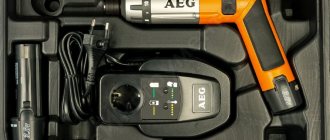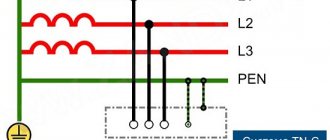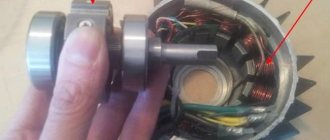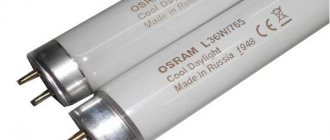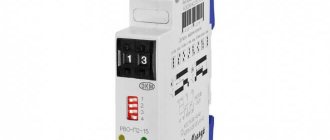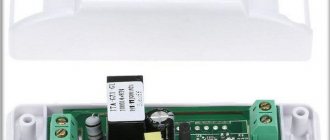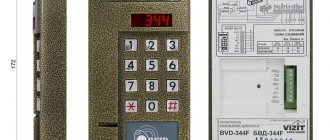Probably in every home there are at least two screwdrivers - a Phillips and a flathead. For many people, this is enough to screw in or unscrew a screw once a year. But screwdrivers, like any tool, do not last forever, and when the time comes to choose new ones to replace the old ones, a person will be surprised and confused. It turns out there are not two or even two dozen types of screwdrivers; in a decent store they can have a whole section dedicated to them. How to choose a screwdriver that suits your needs, and most importantly, a high-quality screwdriver, and not get confused in their diversity? We will try to answer this question in our article.
Typically, a screwdriver consists of three parts: a handle, a shaft, and a tip. It is clear that the strength of a screwdriver is determined by the reliability of its weakest link.
Tip (sting)
The shape of the screwdriver tip should match the shape of the slot - the groove on the head of the screw or screw. Previously, the most common was a straight slot, but now fasteners with it are increasingly difficult to find, which is why not many straight screwdrivers are produced.
Now the most common is the Phillips slot (also called Phillips). There is also an improved version called Pozidriv. Such slots allow you to achieve greater torque, and the screwdriver tip does not fall out of them as easily as from a straight slot.
There are also hex splines and Torx splines (six-pointed star). They are designed for even greater loads.
Other types of slots can be classified as rare, and we advise you to buy screwdrivers with the appropriate tip shape only if necessary.
In addition to the shape of the tip, you need to pay attention to its size. Ideally, a specific tip size should be used for a specific slot size. Many people ignore this instruction and consider, say, a Phillips screwdriver to be universal, suitable for any Phillips slot. If you choose the wrong tip size and shape, you can break the tool or cut off the slot.
How to choose screwdriver size:
- Flat-head screwdrivers are marked with the Latin letters SL, followed by the width of the slot in millimeters. The width of a flat-head screwdriver can be from 2 to 18 mm; as its width increases, the thickness of the tip also increases. For most everyday tasks, the average user can get by with three flat-head screwdrivers of different sizes, say SL3, SL5 and SL8.
- Phillips screwdrivers are marked with PH symbols with a serial number (000; 00; 0; 1; 2; 3; 4). The most popular screwdrivers are PH2 size; they are suitable for most self-tapping screws and self-tapping screws used in everyday life.
The tip of the screwdriver must not only have the appropriate shape and size, it must be strong, hard, not brittle, and securely fixed in the slot. Achieving strength characteristics is facilitated by high-quality rod material and proper heat treatment.
In order for the tip to be securely fixed in the slot, it must be rough. The tips of high-quality screwdrivers are coated with a special coating with a high coefficient of friction, or notches are applied to its edges.
Spline size
The correct tip size is the key to long service life of the screwdriver. The easiest way is to take with you a sample of the fasteners with which the work will be carried out, and select the appropriate tool for it on the spot when purchasing. If this is not possible, you will have to be guided by the markings.
For a cross-shaped tool, there is a table where each screwdriver is assigned a serial number, and depending on the number, the dimensions of the fasteners to which it fits are indicated, as well as the diameter and length of the shaft of the screwdriver itself. PH2 screwdrivers are the most popular, as they fit most screws and self-tapping screws.
With flathead screwdrivers it’s quite easy. The markings indicate the width and thickness of the blade, as well as the length of the screwdriver and the length of the working part. The most popular are SL3, SL5.
Kernel
Screwdriver shafts can vary in length, diameter, shape and strength. The strength characteristics of a rod are characterized by its hardness. According to GOST, it should be in the range of 47-52 HRC. If the hardness is lower, the rod may bend, if higher, it may crack. It is possible to ensure satisfactory hardness by using high-alloy chrome-vanadium steel; in this case, “CR-V” or “chrome-vanadium” may be written on the rod. But such an inscription does not always guarantee quality, because it is not difficult for unscrupulous manufacturers to apply it. Conversely, famous manufacturers do not always write what, in their opinion, goes without saying. To ensure corrosion resistance, various protective coatings are sometimes applied to the rods. Sometimes the rods are covered with rubber or plastic, this makes the work of electricians easier, but it makes the rod thicker than the tip, so it is not always possible to reach the head of the fastener, which is deeply recessed into the part.
The length of the rod is usually 100-200 mm. For working in tight spaces, screwdrivers with a short shaft and a shortened handle are produced. If the fastener is located in a hard-to-reach place, it is more advisable to use a screwdriver with a long shaft and take a telescopic screwdriver with an adjustable extension of the shaft.
The diameter of the rod depends on the size of the tip and the loads for which the tool is designed. The cross-section of the rod can be not only round, but also hexagonal or square. This shape allows you to grip the rod with a wrench and provide more torque.
We must not forget that the rod must not only be durable, it must be securely fixed in the handle. This factor cannot be controlled visually, so unscrupulous manufacturers often pay insufficient attention to fixing the rod, and over time it begins to rotate. You can safely throw away such a screwdriver, because it will not be possible to revive it.
Sometimes the shaft of a screwdriver extends through the entire handle and ends at a heel that can be struck with a hammer. This screwdriver will come in handy if you need to unscrew a screw with a painted slot.
Types of screwdrivers
The design of a screwdriver is very simple - a handle made of wood, metal or plastic, a rod and a tip (tip). The ability of the tool to work with one or another type of slot depends on the shape of the tip. The sizes of screwdrivers also differ. It is with them that we will begin our review of the tool. Screwdrivers are produced in standard sizes by numbers. Each number corresponds to a specific size of hardware that can be screwed in or unscrewed using the selected screwdriver. The table shows the parameters of screwdrivers with a Phillips (Phillips) and PZ (Pozydrive) cross-tip screwdriver.
| Tool number | Hardware thread diameter, mm | Screwdriver shaft diameter, mm | Rod length, mm |
| 0 | Up to 2 | 4 | Up to 80 |
| 1 | 2,1–3 | 5 | 800– 100 |
| 2 | 3,1– 5 | 6 | 100–120 |
| 3 | 5,1– 7 | 8 | 120–150 |
| 4 | Over 7.1 | 10 | 150–200 |
The sizes of flat-head screwdrivers are marked with the letters SL, followed by a number that shows the width of the blade in millimeters. For example, SL8, SL10, etc. The marking SL0.4X8 is also used, where the first number shows the thickness of the blade in millimeters.
Screwdriver shafts are made from high-quality tool steel with a hardness ranging from 47 to 50 HRC. With a lower hardness, the rod will bend or twist, and with a higher hardness it can simply split under great force or impact. Most quality screwdrivers are made from chrome vanadium or chrome molybdenum steel, the same type used to make wrenches. In this case, there is a marking on the tip or handle, for example, CR-V.
When purchasing, be sure to pay attention to the brand of metal from which the rod is made. Information about this must be indicated in the instrument certificate. If there is no such data, then it is better not to buy a screwdriver. Many unknown brands use soft low-carbon steels to produce screwdrivers, which cannot withstand loads - the tips quickly wear out and lose their shape.
The blade of the screwdriver should correspond as closely as possible to the type of slot in the hardware. For example, the already mentioned Phillips screwdriver type PH is unable to unscrew a tightly tightened screw with a PZ slot, and vice versa. And there are other types of hardware heads. It’s better not to experiment, but to buy a slotted or Phillips screwdriver of the required configuration and size.
The main types of splines are shown in the figure:
- A - straight or slotted screwdriver, also called “minus”.
- B - Phillips, or PH, the very first type of Phillips screwdriver, the most common, also known as “plus”.
- C - PZ (“Pozidriv”), cross-shaped slot with additional grooves, have increased torque.
- D - sprocket, Torx, the torque is higher than that of PZ, but requires full matching of the dimensions of the screwdriver and hardware.
- E - reinforced sprocket with a pin, also designated Torx.
- F - hexagon, hexagon, imbus key, or Hex. The torque is 10 times greater than a flat screwdriver.
- G is a square. Rarely found in screwdrivers, but popular among impact driver bits.
- H - Tri-Wing, shamrock. It is difficult to find such fasteners, except in expensive branded equipment, which is not recommended to disassemble yourself.
- I - Torq, asymmetrical cruciform. Such fasteners are used in high-tech technology to secure parts that are not recommended to be touched. You cannot unscrew them with a regular Phillips or flat head screwdriver.
- K - pin screwdriver. This type of fastener is used in adjustment screws and warranty seals. It is also better not to touch them.
Handle
Screwdriver handles are made from various materials, such as plastic, wood, and may have rubber inserts.
The dimensions of the handle must be selected based on the working conditions. If you have to work in cramped conditions, a short handle is better. Its diameter is almost always proportional to the size of the tip and the diameter of the rod. That is, the more powerful the fastener a tool is designed for, the greater the torque required and the thicker the handle should be. For screwdrivers for small fasteners, the handles are deliberately made thinner so that there is no risk of cutting off the slot or destroying the part into which the fastener is screwed.
The handles of modern screwdrivers can come in a variety of shapes; often manufacturers are guided not only by ergonomics, but also try to somehow distinguish their product from others due to the shape of the handle, sometimes sacrificing convenience. Therefore, when choosing a screwdriver, we recommend that you hold it in your hands.
The handle of a screwdriver can be not only cylindrical; there are T-shaped handles or pistol-type handles. They provide more torque, but make the tool less compact.
The handles of most screwdrivers are made of plastic with rubber inserts. For everyday tasks, this combination is ideal, but for work in contact with aggressive environments, it is advisable to opt for a material that is more resistant to their influence, such as plastic or wood.
On the back of some handles there are metal wrench heads - not an absolute necessity, but in some cases a very useful feature.
It is advisable that there is a hole in the handle, so the screwdriver can be hung on a hook or a cord can be pulled through it and hung around the neck.
Overview of varieties
So what types of screwdrivers are there? Since new types of bolts have appeared on the construction market, the types of tools have also expanded. Today there is a large selection of products of different shapes and designs. Most of them are used only in conjunction with certain technologies.
The following types of screwdrivers are considered the most popular in consumption:
- Flat (designated as SL). It is also called straight-pinned. The tip has the shape of a blade and such a plane is necessary to work with the simplest connections using screws. This device is considered the most popular for household work, such as fixing shelves or minor electrical work.
- Cross (designated as RN). This screwdriver has a cone-shaped blade. Its four faces fit into a cross-shaped slot. These types of products are used to connect certain equipment or cars, as well as to securely fasten a screw. Since such a screwdriver has a conical shape, the tip will come into contact with the screw twice as much.
- Hexagonal (designated as HEX). These types of products have a working surface shape like a hexagon. The torque of such a device will be ten times greater than the readings of a Phillips screwdriver. This type of tool is used during work related to the repair of electrical equipment.
- Star-shaped (designated as TORX). It has the shape of a working surface like a six-pointed star. It is used when repairing minor types of equipment, such as a cell phone.
- Cross-shaped with notches (designated as PZ). This type of screwdriver design not only has a cross profile, but also has minor additional edges. It is used when assembling furniture, as it fits more tightly into the fasteners.
There are also types of products that are used only in certain conditions, as they are equipped with special devices. Such products include:
- Screwdriver with ratchet mechanism. Thanks to this mechanism, the rod can rotate freely in one direction. Due to this, you can work without removing the tip from the slot. The direction of rotation is changed using a special lever.
- Dielectric. Used when working with live equipment. In this case, the product is covered with a special insulating coating. Such insulation is calculated for the established voltage limits. This is indicated in the markings on the handle.
- Universal. Allows you to use multiple tips on one handle. They are stored either in a separate case or inside the handle.
- With flexible shaft. Also called gear transmission. In cramped conditions, such a device will be indispensable, as is clearly shown in the photo:
Additional features
The shaft of some screwdrivers can be replaced by a flexible shaft or equipped with a hinge, thanks to which you can screw the screw into a place where a regular screwdriver cannot reach.
There are also screwdrivers with ratchet. Thanks to the ratchet, free rotation of the handle in one of the directions is ensured, that is, you can screw in the fasteners without taking your hands off the handle.
Nowadays, screwdrivers with replaceable tips are increasingly common, which will satisfy the majority of ordinary users, but pros will bypass them, like any other “universal tool.”
Remember that you can only evaluate the quality of a screwdriver on a store counter visually. Therefore, all manufacturers (conscientious and not) try to make their products look as attractive as possible. We advise you to only buy products from well-known brands.
Screwdriver manufacturers
- Stanley is an American company with production in Thailand. A wide range of screwdrivers of fairly good quality.
- STAYER is a Russian company that produces budget instruments. It produces quite good screwdrivers in its price category.
- Wiha produces premium tools. Screwdrivers from this company are expensive, but high quality
- JONNESWAY is a Taiwanese manufacturer that produces very high quality screwdrivers
- Hama is a company from Germany, production in China. The products of this company are highly reliable
A high-quality screwdriver will last for many years if used correctly. You just have to follow a few simple rules: use a different screwdriver for each screw and do not use the screwdriver as a lever or chisel.
Segmented knife
The most common type is segmented. This is a thin steel plate divided into sections by transverse notches. Each of the sections is a mini-blade sharpened on one side, not inferior in sharpness to a razor. Such a segment can be easily broken off by pressing the plate laterally in the direction opposite to the notch. The knife mechanism allows you to move the plate up and fix it in the desired position. After using the entire length of the blade, it is easy to replace it with a spare one.
The records are produced in widths of 9, 18 and 25 mm. When choosing a replacement kit, be sure to check the width to ensure it matches the dimensions of the handle. With such a knife you can cut either with a separate segment or with the entire length of the blade. But in this case, you need to use the tool very carefully; when pressed from the side, it is easy to break the blade along the notch. A segment-type retractable construction knife is designed for cutting drywall, wallpaper, roofing materials, sharpening pencils, cutting cardboard packaging, linoleum. Consumables are sold in sets of 10 records in a plastic box. For household use, it is best to buy an 18 mm construction knife, which is optimal in size and capabilities.
Mandatory attributes of a segment knife are a steel guide plate and a reliable lock to prevent the blade from moving backward. Without such devices, using the tool is dangerous - the blade, in addition to being fragile, is also very sharp. If it breaks during operation, the likelihood of injury is very high. The best models are equipped with a clamping screw to secure the blade.
The reinforced construction knife deserves special attention. It is equipped with steel guides that hold the blade tightly, a screw lock and shock-resistant pads on the handle. The most durable is a 25 mm construction knife, which is highly versatile.
